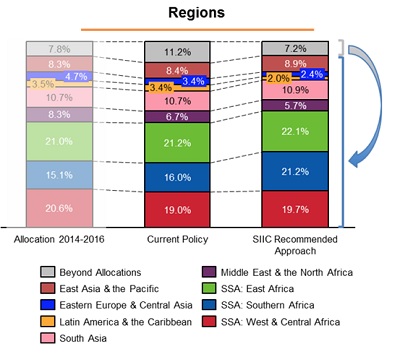Also available in: Español
The Global Fund new allocation of resources was one of the hottest topics at the 35th. Board Meeting, where it was decided to distribute less to more countries and more to less.
By: Javier Hourcade Bellocq
In Ivory Cost, delegates from various blocks that form the Global Fund Board discussed one of the most controversial topics, the allocation of resources, which kept them working until very late at night. A new methodology will cut the investment portfolio, but this is also tied to the ability of the Fund to mobilize money to be invested after 2017.
Funds Allocation Methodology
In November 2015, the Board requested that the funds allocation methodology be improved in a comprehensive way to ensure a higher impact, simplicity, flexibility and predictability, and to achieve the objectives of the Global Fund Strategy 2017-2022. On this basis, the Strategies Committee rigorously evaluated and discussed several holistic approaches, taking into account the lessons learnt from the implementation of the allocation methodology 2014-2016. At its 17th meeting, in March 2016, the committee finished its discussions and completed its package of refinancing recommendations to maximize the impact of the Global Fund resources. l
allocation methodology be improved in a comprehensive way to ensure a higher impact, simplicity, flexibility and predictability, and to achieve the objectives of the Global Fund Strategy 2017-2022. On this basis, the Strategies Committee rigorously evaluated and discussed several holistic approaches, taking into account the lessons learnt from the implementation of the allocation methodology 2014-2016. At its 17th meeting, in March 2016, the committee finished its discussions and completed its package of refinancing recommendations to maximize the impact of the Global Fund resources. l
Out of the total amount collected, the Global Fund will allocate only 800 million US Dollars to increase coverage in the countries and another identical amount for what is called a catalytic fund. The resources for our countries and regional organizations come from this last one. Both could not exceed 15% of available resources. There has also been the request to the Secretariat for extreme flexibility in the use of these funds.
Most of the money that the Fund will mobilize in this resource replenishment cycle will be invested in fifteen countries, in nine of them for HIV programs. This is a proposal for the fulfillment of the new Global Fund strategy, which seems unlikely to happen with this allocation. Fewer resources will be available to the region, for national allocations, and even less resources for the multi-country and regional programs. These amounts will be subject to the fact that the Fund may mobilize 13 billion dollars in the coming months, an unlikely scenario. 50% of the amount collected will be allocated to HIV and 18% to Malaria.
Allocation formula
 The approved formula is that among the countries that are still eligible and that recently have had a budget allocation, there will be a reduction in the whole portfolio with the following criterion:
The approved formula is that among the countries that are still eligible and that recently have had a budget allocation, there will be a reduction in the whole portfolio with the following criterion:
1. Each component of the eligible country, that had a previous funding level below its initial calculated value, will receive a funding level that is at least in the middle point between its initial calculated value and its previous funding level;
2. Each component of the eligible country, that had a previous funding level above its initial calculated value, will have a reduction of at least 25 percent of its previous funding level; and Table 1 Allocation percentages per country (without catalytic fund).
3. Previous funding level represents the real and foreseen use of funds derived from the allocation of a previous period.
Some qualitative factors that could help in making adjustments are: (1) The main sources of external funding; (2) The minimum funding levels; (3) The willingness to pay; (4) The history of the program performance and absorption capacity; (5) Risk; (6) Increase of rates of new infections in countries with the lowest prevalence and (7) Concentration on key populations.
Funds reallocation
The Secretariat will be able to carry out a strategic reallocation of available funds, based on the following parameters:
Funds that are additional to the amount initially allocated to the components in eligible countries must be reallocated to prioritized sectors and budgeted as identified necessity, registered at the initial submission and the review of a funding request, following an order of priorities prepared by the Secretariat and approved by the Committee in charge of strategy matters, that ensures priority based on the degree that the allocation of a formula derived from a country component is below its initial calculated value; and
The allocation of available funds to the programs will be recommended by the Secretariat to the Board for approval.
The catalytic fund
 Based on the recommendations of the committee in charge of strategy matters, the Board approved the use of up to 800 million dollars to fund catalytic investments through approaches of multi-countries, strategic initiatives to promote the use of resources for strategic priorities, even for key and vulnerable populations.
Based on the recommendations of the committee in charge of strategy matters, the Board approved the use of up to 800 million dollars to fund catalytic investments through approaches of multi-countries, strategic initiatives to promote the use of resources for strategic priorities, even for key and vulnerable populations.
Table 2: Allocation by income level (without catalytic fund).
The Secretariat will be able to determine the portion of fund sources available for catalytic investments that may be used to provide additional funds for country allocations; whenever possible, the Secretariat should recover funds for catalytic investments from those funds granted through the corresponding grant programs.
What does this all mean?
This Board decision represents, in relative and absolute terms, a lower investment in the region, in Latin America from 3.4% of the total fund to a new total of 2% (see table 1). It is still unknown how much money from the Catalytic Fund will be invested in the region. We have included table 2, about the allocation based on income, but a significant difference is not seen, given that South Africa, a high-income country, receives funds due to the extreme epidemic level, and today in Africa, there are some middle-income countries that will go through transition.
 In absolute terms, the region loses a third of the money it used to receive. This is an estimate. Until the Strategy Committee meets in June, we will not know for sure the most affected countries. There will be several in Latin America, one could predict that Peru, Ecuador and Colombia begin their irremediable transition out of the Global Fund as well as several Central American countries. Some countries have just started a project and it has not been absolutely decided whether this will be their transition or if they will have three more years. Unless something positive and drastic happens, this is the future scenario, “live with what is ours”. The priority for the coming years, better late than never, is to focus our efforts on sustainability and an orderly transition.
In absolute terms, the region loses a third of the money it used to receive. This is an estimate. Until the Strategy Committee meets in June, we will not know for sure the most affected countries. There will be several in Latin America, one could predict that Peru, Ecuador and Colombia begin their irremediable transition out of the Global Fund as well as several Central American countries. Some countries have just started a project and it has not been absolutely decided whether this will be their transition or if they will have three more years. Unless something positive and drastic happens, this is the future scenario, “live with what is ours”. The priority for the coming years, better late than never, is to focus our efforts on sustainability and an orderly transition.
Our countries must cover most of the bills in a few years, including health systems, condoms, campaigns, medication and inputs. This is only possible with the commitment from governments and with reasonable prices.
The big challenge will be where civil society gets its financial resources from; in some countries of the region this is possible to get from governments, in others it is a matter of futurology or science fiction. From here we call for mobilization to participate actively and critically in the orderly exit from the Fund, for advocacy with our governments and for creative and innovative thinking on the subsistence of civil society.
